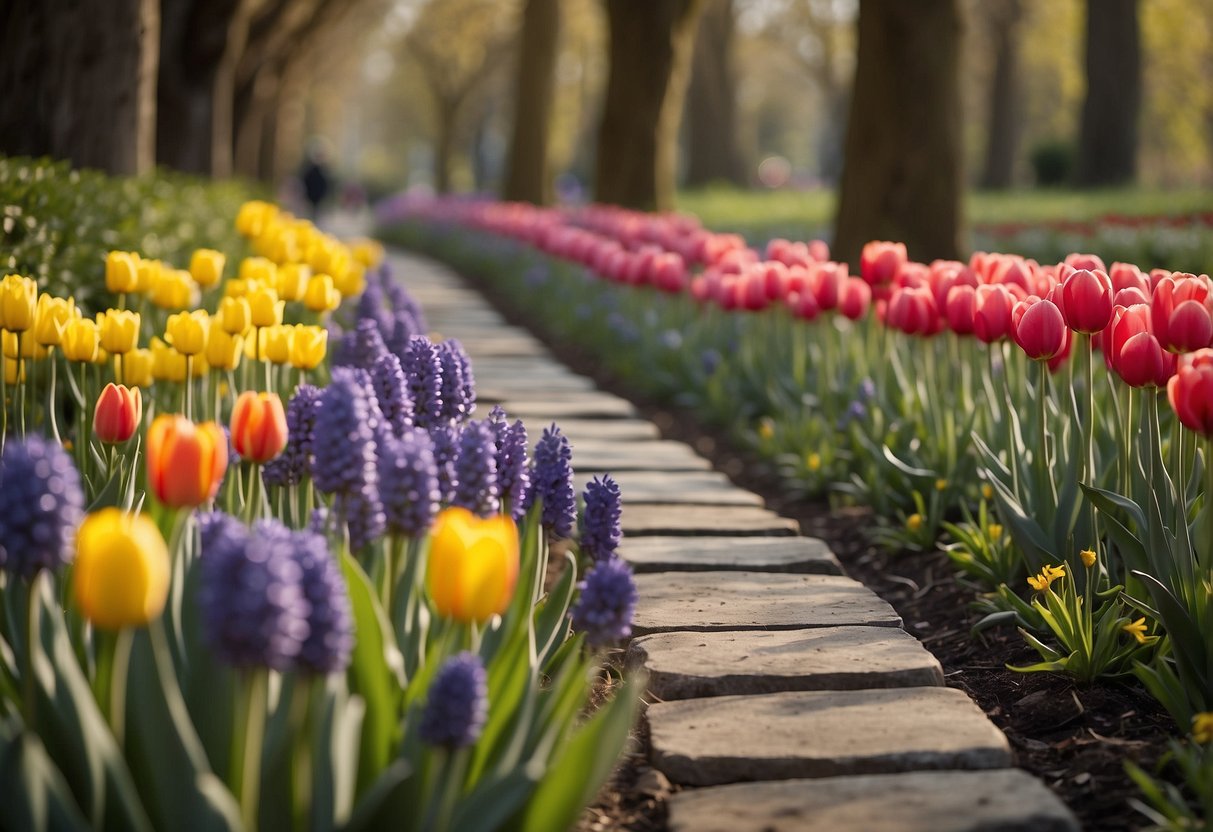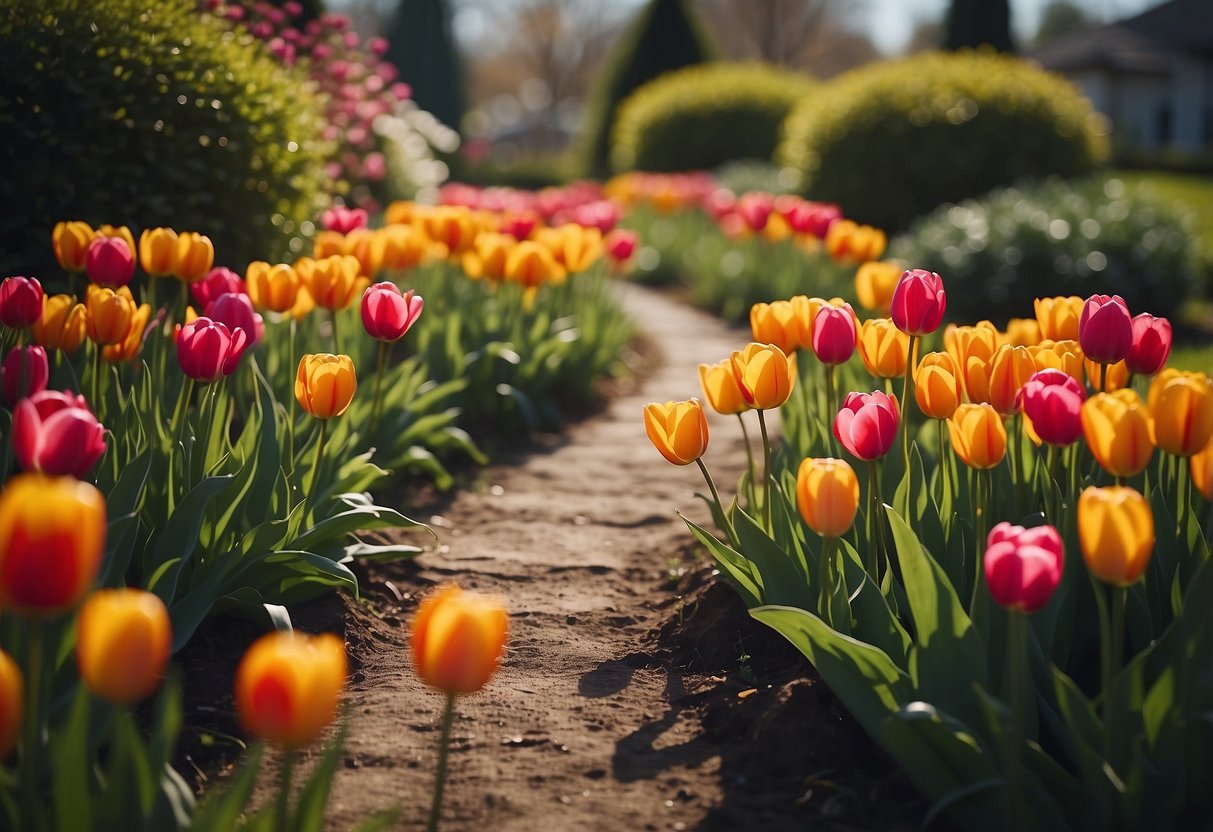Front Yard Spring Flower Garden Ideas: Brighten Your Home
A beautiful front yard flower garden can transform your home’s exterior, creating a welcoming and vibrant space that greets visitors. As spring approaches, it is the perfect time to think about refreshing your landscape with a variety of colorful flowers and plants that will bloom through the season.

Wondering how to start your spring garden and make your front yard stand out? This article will introduce you to insightful ideas and useful tips to help you create a stunning front yard flower garden that showcases your personal style while enhancing your home’s curb appeal. Get ready to explore creative and practical options that will bring your spring garden to life.
1) Tulip Pathway

Create a charming tulip pathway to welcome guests. Line the path to your front door with colorful tulips. Mix different colors like red, yellow, and purple for a bright and cheerful look.
Vary the heights of the tulips to add visual interest. Use taller tulips in the back and shorter ones in the front. This adds depth to your garden.
Consider adding brick or stone edging to define the pathway. For ideas, visit FreshPatio’s tulip garden designs. Your tulip pathway will be a beautiful sight every spring.
2) Daffodil Delight

Daffodils are a perfect way to brighten up your front yard in the spring. Their cheerful yellow blooms can create a welcoming atmosphere.
You can plant daffodils in clusters around trees or along pathways. This will add both color and structure to your garden.
Consider mixing daffodils with other spring flowers like grape hyacinth or English ivy for a fuller look.
3) Lavender Borders

Lavender borders can add a beautiful touch to your front yard. The vibrant purple flowers create a striking contrast with green lawns and other plants.
These borders not only look good, but they also smell great. Lavender’s fragrance can create a lovely scent around your home.
Lavender is a hardy plant, making it easy to maintain. It thrives in well-drained soil and sunny spots. This makes it an ideal choice for many front yards. For more details, check out lavender front yard ideas.
4) Peony Parade

Peonies are a fantastic addition to your front yard. Their big, bright blooms make such a cheerful statement. You can plant them in various colors like pink, red, white, and even yellow.
For a standout look, try mixing different shades of pink peonies. Blend them with purple or white flowers to create eye-catching contrasts.
Imagine a colorful landscape where peonies practically invade your lawn, adding vibrant touches. With peonies, your front yard will be a stunning paradise that leaves a lasting impression.
5) Sunflower Corner

Turn a corner of your front yard into a bright and cheerful sunflower spot. Choose a sunny location, as sunflowers need plenty of light.
You can plant dwarf sunflowers if you have limited space. They grow to about 12-18 inches tall and add charm to your garden.
Consider using a raised bed to make the sunflowers stand out even more. This setup can create a stunning visual effect.
To keep things tidy, consider adding a white picket fence around your sunflower corner for a neat and charming look.
6) Iris Island

Creating an Iris Island in your front yard is a delightful way to add color and charm. Iris flowers come in various shades, making your garden burst with beauty.
Plant a mix of different iris varieties for a multi-color display. Choose a sunny spot with well-drained soil for the best results.
Adding mulch, like wood chips, helps retain moisture and keeps weeds away. Incorporate small rocks around the plants to enhance the natural look. An Iris Island will surely become a lovely focal point in your yard.
7) Lilac Blossom

Lilacs are a delightful addition to any front yard flower garden. They are known for their vibrant and fragrant blossoms that bloom in the spring. Lilacs come in a range of colors, including purple, pink, and white.
Lilacs thrive in full sun and well-draining soil. Make sure you water them properly; water the lilacs when the topsoil dries out, usually every 10 to 14 days during dry spells.
When planting lilacs, space them out to allow for growth. They can spread up to 15 feet wide. Consider getting your lilac shrubs from a trusted nursery or garden center.
To maximize blooms, clear a 2- to 3-foot area around the base, and add a loose layer of mulch. This helps keep the roots cool and moist.
Lilacs can grow quite tall, reaching up to 25 feet. They make perfect backdrops for your front yard garden. Plus, they add a lovely, welcoming fragrance to your home.
8) Hydrangea Haven

Transform your front yard into a peaceful oasis with hydrangeas. These gorgeous blooms add vibrant colors and lush greenery.
Plant hydrangeas along pathways or frame your entryway. They thrive in partially shaded areas, making them perfect for your garden’s shady spots.
Mix hydrangeas with foliage plants like hosta for a stunning contrast. Large containers also work well if space is limited.
Get inspired by more ideas for a Hydrangea Haven to create a captivating garden.
9) Rose Arbor

Adding a rose arbor to your front yard can elevate its beauty instantly. A rose arbor serves as a beautiful focal point and offers a lovely structure for climbing roses.
Place the arbor at your entrance or over a walkway. This creates a grand and welcoming atmosphere for guests.
Choose roses like ‘Blaze’ climbing roses, known for their vibrant red hues. These can grow over the top, creating a stunning aesthetic. For more ideas, you can explore rose garden ideas.
10) Cherry Blossom Tree

Adding a cherry blossom tree to your front yard can create a stunning visual impact. Known for their beautiful flowers, these trees burst into bloom in spring, offering shades of pink and white.
There are many types of cherry blossom trees. For example, the Prunus ‘Shirofugen’ opens with pink buds that turn white, while the Prunus serrulata ‘Kwanzan’ has deep pink double flowers.
Cherry blossom trees are generally easy to care for. Plant your tree in full sun and ensure it gets well-drained soil for the best blooms.
Choosing the Right Flowers

Choosing the right flowers for your front yard garden involves considering plant types, local climate, and color palettes to create a beautiful and cohesive look. This will ensure your garden looks stunning throughout the season.
Perennials vs. Annuals
Perennials are plants that come back year after year. They save you money and effort because you don’t need to replant them every season. Some popular perennials include daylilies, hostas, and coneflowers. These plants usually require less maintenance and can fill out your garden over time.
Annuals, on the other hand, bloom for a single season. They provide vibrant color but need replanting each year. Petunias, marigolds, and zinnias are great choices. They can be mixed with perennials to give your garden a pop of color. Using a combination of both can balance long-term growth with seasonal flair.
Climate Considerations
Your local climate plays a major role in flower selection. If you live in a dry area, consider drought-tolerant plants like lavender or penstemon. These plants thrive with less water and are easier to maintain. Adding mulch around them can help retain moisture, reducing the need for frequent watering.
In cooler climates, choose flowers that can withstand frost and low temperatures. Daffodils, tulips, and chrysanthemums are cold-hardy options. Always check the hardiness zone for each plant to ensure it will survive in your area. For more ideas on creating a water-wise garden, visit this article.
Color Combinations
Choosing the right color combinations can make your garden visually appealing. Bold, contrasting colors like yellow and purple can create a vibrant look. Soft, complementary colors such as pink and white can evoke a sense of calm.
Consider the blooming time of each flower to ensure a continuous display of color. Group similar shades together for a harmonious effect, or mix bright and subtle hues for diversity. For an eye-catching focal point, plant taller flowers at the back and shorter blooms at the front. This approach adds depth and structure to your garden. Learn more about choosing flowers based on height and texture here.
Choosing the right flowers by balancing perennials and annuals, considering your climate, and selecting effective color combinations will make your front yard garden flourish all spring.
Designing Your Garden Layout

Creating a beautiful front yard flower garden starts with a well-thought-out layout. Key elements include establishing focal points, proper spacing and planting, and incorporating pathways and borders.
Creating Focal Points
To make your garden stand out, start by choosing a focal point. This could be your front door, a large tree, or a striking garden statue. Your goal is to direct the eye toward this spot.
Plant taller flowers like sunflowers or hollyhocks near the focal point. Use plants with varying heights, textures, and colors to create visual interest around it. For example, place tall plants at the back and shorter ones in front, forming a tiered effect.
Consider adding a water feature or a birdbath. These not only attract wildlife but also add charm to your garden. Experiment with different elements to see what best complements your yard’s overall look.
Spacing and Planting
Proper spacing is crucial for the health and growth of your plants. Crowded plants compete for light, water, and nutrients, leading to poor growth. Follow the recommended spacing guidelines for each plant type, which you can find on the seed packets or plant tags.
Group plants with similar water and sunlight needs together. This makes watering and maintenance easier and more efficient. For instance, place sun-loving flowers like marigolds and petunias in sunny spots and shade-tolerant plants like hostas in shaded areas.
Stagger planting times to ensure your garden blooms throughout the season. Plant a mix of early spring flowers, like daffodils, mid-season bloomers like lilies, and late bloomers like asters to keep your garden colorful all season long.
Incorporating Pathways and Borders
Pathways and borders not only define different areas of your garden but also make it easy to navigate. Use materials like gravel, brick, or stepping stones to create pathways. These materials are durable and add texture to your garden.
Pathways should lead to focal points and other important areas of your yard. Curved pathways can create a sense of mystery and make the garden feel larger. Plant low-growing flowers like alyssum or creeping thyme along the edges to soften the look.
Borders serve to frame your garden beds. Use materials such as wooden planks, metal edging, or natural stones to create clean lines. Borders help keep mulch and soil in place and prevent grass from encroaching into your flower beds.







